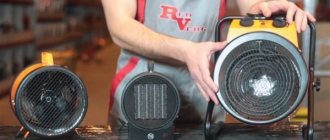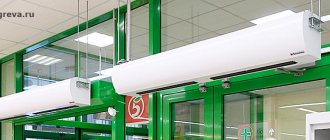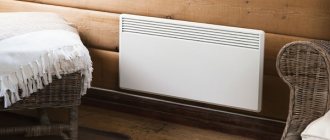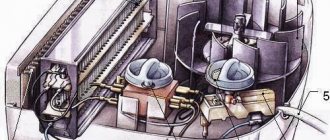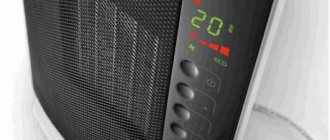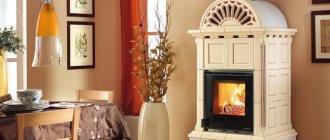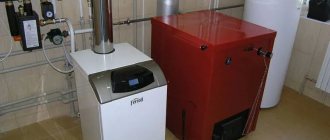Heating a room in which one or more doors are constantly open is a thankless task. Heating devices operate at full power, but heat still escapes through doorways.
The optimal solution would be to install a barrier in the opening that allows people to pass through, but is an obstacle to external air flow. Such a device is called a thermal curtain, as it creates a flat flow of warm air in an open opening and prevents warm masses from escaping outside and cold air from entering inside.
Air flow protects the doorway
Features of the thermal curtain
Vertical and horizontal thermal curtains can often be seen at the entrance to:
- Administrative building;
- Medical and educational institutions;
- Supermarket;
- Hotel;
- Subway station;
- Railway station;
- Warehouses or hangars;
- Production workshops.
Areas of use
There is an urgent need for the use of such devices in rooms where a large flow of people constantly open and close doors, creating drafts.
Such premises include:
- restaurants;
- the shops;
- metro;
- warehouses and industrial workshops;
- checkpoints;
- office halls class=”aligncenter” width=”800″ height=”600″[/img]
Operating principle of a thermal curtain
The design and operating principle of the device is not that complicated. The body of the thermal curtain contains a heat source and a fan of sufficient power. The latter creates a flow of heated air in a certain direction.
In the area of operation of this device, an atmosphere with increased pressure is created, which does not allow during the cold season:
- Bring air from outside into the room;
- Release warm air outside.
Often similar devices are used in the warm season, but in this case the curtain acts as an air conditioner, preventing warm air, exhaust gases, insects and dust from entering from the outside. With the help of thermal curtains you can get rid of drafts.
Functions of air curtains
- Zoning function. Divides rooms into zones, for example zones with warm and cold air masses. In a cafe, these can be areas with smoking and non-smoking tables.
- Clipping function. Separates street air from indoor air.
- Dehumidification and heating function. Warm air is supplied and a stream of air dries the floor under the curtain.
- Circulation function. Accompanies air circulation indoors.
Varieties by location
It is more rational to place thermal curtains as close as possible to the front door.
Methods for installing thermal curtains can be different:
- Horizontal - installed above the doors, the air flow is directed downwards.
- Vertical - fixed from the side. The device can be installed unilaterally or bilaterally, which depends on the dimensions of the doorway and the power of the fan.
- Column - devices in the form of racks, installed in pairs or individually. The air flow is directed horizontally, separating the exit from the room with a warm curtain.
- Ceiling (hidden installation) - designed for installation in suspended ceilings. Of the structural elements, only the air supply grilles are visible.
Popular models
Below are the models that have received the largest number of positive customer reviews.
Ballu BHC-L10-S06-M (6 kW)
Thermal curtain Ballu BHC-L10-S06-M (6 kW)
Characteristics:
- Power adjustment: yes
- Power levels: 6000/3000 W
- Maximum air exchange: 700 m3/h
- Voltage: 220/230 V
- Fan: yes
- Ventilation without heating: yes
- Noise level: 52 dB
- Mounting options: wall
- Heat curtain installation: horizontal, max. installation height 2.50 m
- Dimensions (WxHxD): 108×15.5×15 cm
- Weight: 9.1 kg
Ballu BHC-B10T06-PS (6 kW)
Thermal curtain Ballu BHC-B10T06-PS (6 kW)
Characteristics:
- Power adjustment: yes
- Power levels: 6000/4000 W
- Maximum air exchange: 1100 cubic meters/h
- Voltage: 220/230 V
- Thermostat: yes
- Wi-Fi: no
- Bluetooth: no
- Mounting options: wall
- Heat curtain installation: horizontal
- Dimensions (WxHxD): 112.5×19.8×21.5 cm
- Weight: 12.8 kg
Timberk THC WS1 9M (9 kW)
Thermal curtain Timberk THC WS1 9M (9 kW)
Characteristics:
- Power adjustment: yes
- Power levels: 9000/4500 W
- Heating element type: heating element
- Maximum air exchange: 1160 cubic meters/h
- Voltage: 380/400V
- Fan: yes
- Ventilation without heating: yes
- Thermostat: yes
- Timer: no
- Mounting options: wall
- Heat curtain installation: horizontal, max. installation height 2.20 m
- Protective functions: overheat shutdown
- Dimensions (WxHxD): 159.7×18.3×12 cm
- Weight: 12.8 kg
By type of heat source
Sources supplying heat to the curtain can be in two main versions:
Electrical
Such devices are equipped with a heating element that is connected to an electrical network with a voltage of 220V or 380V. Devices of this type are quite compact, easy to operate, install and maintain.
The latest models have adjustments for the degree of heating, air flow power, air temperature, and a timer.
Mermen
The devices are equipped with a tubular heat exchanger that passes the coolant from the heating system of the building. These devices are large and quite difficult to connect. The advantages include increased cost-effectiveness.
There are also devices heated by gas, but such models are extremely rare.
Heating element type
The electric heater of the thermal curtain can be in the form of a spiral or a heating element.
Spiral
An effective but not durable heating element option. Efficiency is achieved due to the strong heating of the wire, and the service life depends on its quality and endurance.
heating element
This heater is more modern than the previous version and has a tubular body filled with quartz sand. There is a spiral running inside it. This device has high heat transfer and a long service life.
Control and Security
The electric heat curtain has a built-in electronic control unit that controls the operating parameters of the device. The speed of air movement, the direction of its movement, and the temperature of the flow are controlled. These parameters are set from the portable remote control. In addition, the temperature of the heating elements is controlled. When the maximum value is reached, the heating is turned off. This value - the shutdown threshold - is set at production and there is no way to adjust it.
Some time-tested brands
There are also more complex controls. With built-in sensors for motion, outdoor and indoor temperature, and wind speed. Based on the readings of these sensors, the optimal operating parameters for all system components are automatically selected. It is convenient and economical, but such control is expensive.
Selecting a thermal curtain
There are some tips for choosing a thermal curtain, one of which recommends taking into account the following points when purchasing:
- Dimensions of the open opening;
- The height of the ceiling in the room;
- Installation level;
- Curtain dimensions;
- Type by location;
- Productivity;
- With room heating or not;
- The need to adjust the heating;
- Heater type;
- Pair or single installation is needed;
- Specifications;
- Features of the installation site;
- Compliance with desired requirements.
Key parameters to consider when choosing.
Specifications
To understand how to choose a suitable thermal curtain, you need to understand the basic technical parameters of these devices. Choose the device that will protect your door:
- Dimensions. The length of the device must ensure that the heat flow completely covers the width of the doorway. Even a small gap will significantly reduce the effectiveness of protection from external influences. To select protection over wide doors in large rooms - supermarkets, auto repair shops - you can install several devices located along the entire width of the opening. The height of the device also matters. If it is larger than the free space above the protected opening, then you will probably have to abandon the horizontal type of curtain and consider only options with a vertical type, located on the side of the doors.
Creating a long thermal curtain from four elements
- Airflow performance. The task of a thermal curtain is not to heat the room - this role is performed by other devices. Therefore, the fan power and, accordingly, the volume of air flow per unit time and its speed are the main parameters of the thermal curtain. To reliably set up a protective flow, its speed at the farthest point is required to be about 2 m/s. To ensure such a flow rate near the floor, it is necessary that the device located at a height of 2.5 m “produce” a speed of about 8 m/s. To ensure such speeds, devices with a capacity of more than 600 m3/hour are required.
- Noise level. If for industrial premises and large supermarkets this is not the most determining parameter, then for household devices it is critical. At home, a noise level of less than 70 dB is required for comfort.
- Availability of automatic control. Manual mode is only good for the simplest and cheapest options. Automatic control of the operation of the curtain and the temperature of its heating elements ensures its efficiency and economy.
- Protective devices. For safety, it is necessary to be able to automatically shut down the system when it overheats.
Thermal power
If the room is equipped with sufficient heating, then you can choose a curtain model with no heating function.
Often, devices with a power of 6 to 12 kW are installed for standard door openings, but in practice it turns out that a less powerful device is sufficient for these places.
It is important that the consumption of the device matches the capabilities of the premises network. Particular attention should be paid to the technical characteristics of the network and equipment in the case when the curtain is used as additional heating.
Additional selection criteria
For the thermal curtain to operate efficiently, so that it can fully cope with all its functions, you need to pay attention to some design features of the device and follow certain rules for its operation:
- Possibility of emergency shutdown;
- If the device is equipped with an air conditioning function, it is able to maintain the desired temperature, while reducing energy costs. In addition, these models cut off hot air and dust coming from the street in the summer, which creates a comfortable and beneficial atmosphere for the human body;
- It is advisable if the device is installed single, with sufficient power. This way the flow will be distributed evenly, eliminating breaks, which provides excellent protection against penetrating cold air.
- The most economical thermal curtains are those with ceramic heaters. They consume 20-30% less electricity than heating elements, but their cost is quite high and they are less efficient.
When choosing a thermal curtain, reliability and ease of use play a huge role.
You should not forget about the purpose, which may be its intended purpose, as backup or auxiliary heating of the room. It is also worth considering that in Russia these devices are untenable as an independent source of heating.
Unique advantages of the system
Water thermal curtains have such design features that give them a number of advantages over electric heating devices:
- Less energy consumption with equal heat transfer. Cost savings can reach 30%.
- Possibility of installation in case of technical difficulties: insufficient power of the electrical network, large opening height (up to 12 meters).
- Convenient maintenance due to the simplicity of the design.
- Maintaining a stable temperature in the room and equalizing the temperature difference in the ceiling area and at the level of human growth - this makes it more comfortable for people to stay in the room and creates favorable conditions for storing any goods.
- Neutralization of drafts, which leads to a reduction in the risk of colds.
- Protection against the entry of insects, small animals, and dust into the building.
- Can be used as an air conditioner if the coolant circulation system is turned off.
A water curtain creates additional convenience at car service stations, car washes, checkpoints and public catering outlets, since thanks to it the front door can always remain open. In addition, it not only creates insulating protection, but also serves as a heater for the warehouse vestibule.
The scope of its application depends on the functionality of the equipment: from air screening of warehouses and hangars to preserving the interior of an office or shopping center from street dust.
